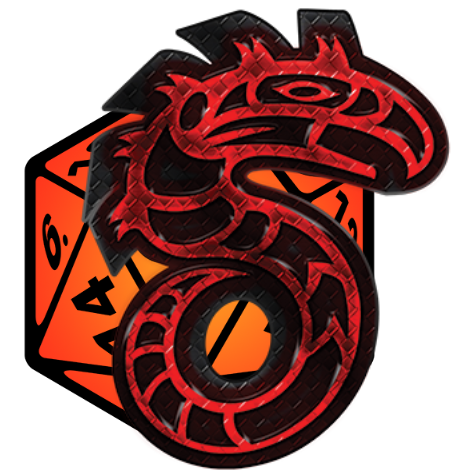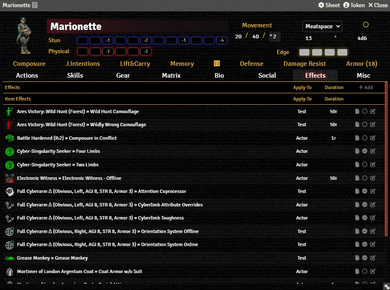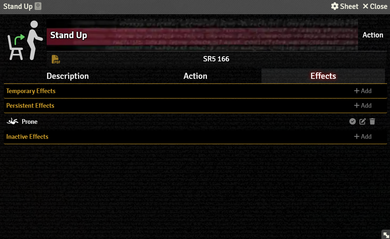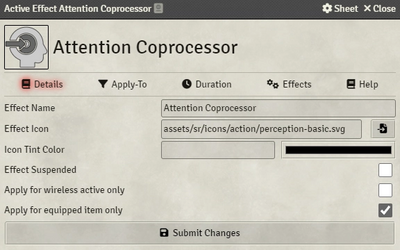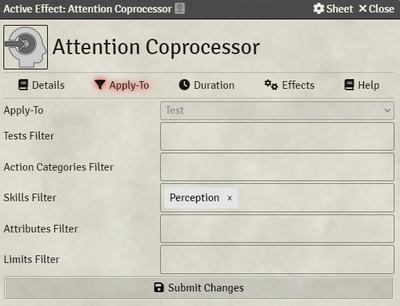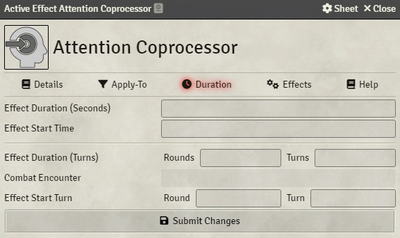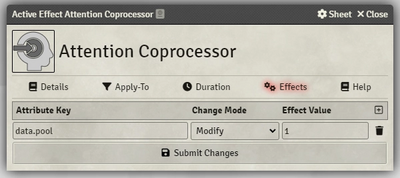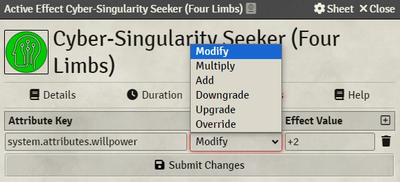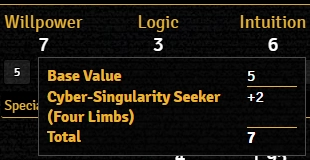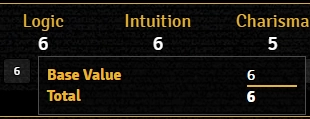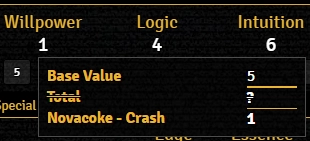Mr. Johnson (talk | contribs) No edit summary |
Mr. Johnson (talk | contribs) No edit summary |
||
| Line 1: | Line 1: | ||
{{Needs Improvement|This article is currently a work in progress. It does not fully reflect the state of the Active | {{Needs Improvement|This article is currently a work in progress. It does not fully reflect the state of the Active Effects system as implemented in {{Ver|0.18.0}} and later.}}[[Category:Content]]__NOTOC__{{Imagebox|sr5-actor-effects.webp|Character Actor Sheet Effects Tab|f=11.315|s=0.18.4|float=right|width=390px}} | ||
{{Imagebox|sr5-item-action-effect.png|Action Item Effect Tab|f=11.315|s=0.16.1|float=right|width=390px}} | {{Imagebox|sr5-item-action-effect.png|Action Item Effect Tab|f=11.315|s=0.16.1|float=right|width=390px}} | ||
The | The system implements '''Active Effects''' as they're used in other systems like DnD5e, with extended capabilities specific to SR5's needs. Active Effects allow you to change an {{Category|Actor}}'s values dynamically with easily toggleable options. You can add an Active Effect to an Actor by either: | ||
* creating it directly on the {{Tab|Actor|Effects}}. | * creating it directly on the {{Tab|Actor|Effects}} by clicking {{Code|+ Add}}. They will show up in the "Effects" category on the actor (the example to the right doesn't currently have any Actor-specific effects). | ||
* creating an | * creating an {{Category|Item}} that supports Active Effects, adding it there, then giving the Actor the Item. They will show up in the "Item Effects" category. | ||
==Change Mode== | ==Details== | ||
{{Imagebox|fvtt-active-effect-details.webp|Active Effect Details Tab|f=11.315|s=0.18.4|float=none}} | |||
==Apply-To== | |||
{{Imagebox|fvtt-active-effect-applyto.webp|Active Effect Apply-To Tab|f=11.315|s=0.18.4|float=none}} | |||
==Duration== | |||
{{Imagebox|fvtt-active-effect-duration.webp|Active Effect Duration Tab|f=11.315|s=0.18.4|float=none}} | |||
==Effects== | |||
{{Imagebox|fvtt-active-effect-effects.webp|Active Effect Effects Tab|f=11.315|s=0.18.4|float=none}} | |||
===Change Mode=== | |||
{{Imagebox|fvtt-active-effect-modes.webp|Active Effect Modes|f=11.315|s=0.17.1|float=none}} | {{Imagebox|fvtt-active-effect-modes.webp|Active Effect Modes|f=11.315|s=0.17.1|float=none}} | ||
There are a number of different '''Change Modes''' available to control how the Active Effect interacts with the Actor's properties. | There are a number of different '''Change Modes''' available to control how the Active Effect interacts with the Actor's properties. | ||
| Line 42: | Line 51: | ||
* {{Code|system.limits.<limitName>}} contains all limits. | * {{Code|system.limits.<limitName>}} contains all limits. | ||
* {{Code|system.modifiers}} contains all global modifiers and can be directly modified. | * {{Code|system.modifiers}} contains all global modifiers and can be directly modified. | ||
{{References}} | {{References}} | ||
Revision as of 15:36, 11 January 2024
This article was last edited Thursday, January 11, 2024 by Mr. Johnson.
The system implements Active Effects as they're used in other systems like DnD5e, with extended capabilities specific to SR5's needs. Active Effects allow you to change an Actor's values dynamically with easily toggleable options. You can add an Active Effect to an Actor by either:
- creating it directly on the Actor's Effects Tab by clicking
+ Add. They will show up in the "Effects" category on the actor (the example to the right doesn't currently have any Actor-specific effects). - creating an Item that supports Active Effects, adding it there, then giving the Actor the Item. They will show up in the "Item Effects" category.
Details
Apply-To
Duration
Effects
Change Mode
There are a number of different Change Modes available to control how the Active Effect interacts with the Actor's properties.
Modify
Modify is the "custom" mode for the SR5 system. This mode will either add a modifier to a value or add directly to it if a modifier can't be applied. Select this mode unless you've determined a specific reason one of the other modes is more appropriate.
If the value has a .mod value, it technically doesn't matter if a general value as a whole or any of it's fields are choosen (such as .value, .base, .mod or .temp). Modify mode will always act on the base node (such as syste.attributes.willpower) — specifying other fields at the same level as .mod will be ignored. If the value choosen includes a .mod field the system will display the effect in the calculation hover tip, where available.
If the value doesn't include a .mod node the Modify mode it will fall back to using the Add mode.
Multiply
For example, one might think to use Multiply and target system.movement.* for equipment like Skates or Skimmers[sr 1], but it won't have the intended effect. Instead, adjust the multipliers by targetting system.modifiers.walk and system.modifiers.run with Modify. Use an Effect Value of "+1" on .walk to change the math from "Agility × 2" to "Agility × 3" and "+2" on .run to change the multiplier from ×4 to ×6.
Like Add (below), there is very little reason to use Multiply. It does properly functions with some values feature elements like .base, but there are few places in the game rules where this is desirable. Use with caution, if at all.
Add
There is no good reason to use the Add mode directly — anything it can do, Modify can do, and returns more detail back to the user. Using Add over Modify bypasses the system's logic, and can lead to errors including corrupt sheet appearance.
Downgrade & Upgrade
The Downgrade and Upgrade[git 1] modes adjust a value, lowering the targetted value if above the effect value on Downgrade, or the opposite for Upgrade. They do not interact with or override calculated values — they should only be used with .base nodes, rather than .mod or .value. If the desired element has no .base node, they may not behave as desired or at all.
Override
The Override mode has been heavily modified from other systems and functions with similar logic to the Modify mode, but the target node must contain a .mod field.
The Override mode is applied last and will replace any calculated value with the value specified in the Active Effect. It will show in the calculation overview popup, identifying that it is replacing the normally calculated value by showing it crossed out.
Should you define multiple Override effects on the same value, only the last one applied will take effect.
Actor Data Structure
If you can't find what you're looking for, check if a global modifier for it exists. Some values contain temp fields, that can be modified by Active Effects.
system.attributes.<attributeName>contains all attributes.system.skills.active.<skillName>contains all active skills. Custom skills will be shown with a random ID. To see the actual custom name of the skill traverse into it and read it's name field.system.limits.<limitName>contains all limits.system.modifierscontains all global modifiers and can be directly modified.
References
GitHub Issues
Sourcebook
- ↑ Chrome Flesh (p. 88)
